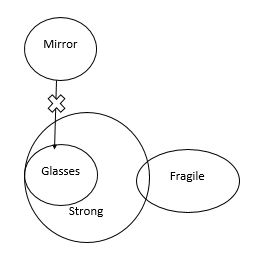Question
Statements: I. Some Mirrors are not
Glasses. II. All Glasses are Strong. III. Some Strong are Fragile. Conclusions: I. Some Mirrors may be glasses. II. Some Glasses are Fragile. III. All Mirrors are Strong. IV. Some Mirrors are Fragile. In the question, below are three statements followed by four conclusions numbered I, II, III, and IV. You have to consider the statements to be true even if it seems to be at variance from commonly known facts. You have to decide which of the given conclusions, if any, follows from the given statements.Solution

For Domestic Scheduled Banks, what is the minimum target for Priority sector lending
Since the middle of the previous decade, RBI and the government have made dedicated efforts in terms of calibrated policy measures like strengthening th...
Which of the following steps were taken during the Liberalisation process in India?
I- The new policy encouraged the entry of private sector firm...
According to the guidelines on the India-UAE Comprehensive Economic Partnership Agreement (CEPA), which entity is responsible for overseeing the import ...
With respect to the Expenditure Budget, which of the following does not come under the Umbrella of Centers’ Expenditure there sub-classification?
Which of the following is the fiscal deficit for the current year minus interest payments on previous borrowings?
Under the “Credit Enhancement Scheme”, IIFCL provides credit enhancement by way of unconditional and irrevocable partial credit guarantee to enhanc...
Which one of the following is not a function of NABARD?
Payment Banks in India are prohibited from performing which of the following activities?
What is the primary purpose of the Indian Financial System Code (IFSC code) issued to International Banking Units (IBUs) as per the March 2024 IFSCA cir...
Relevant for Exams:


